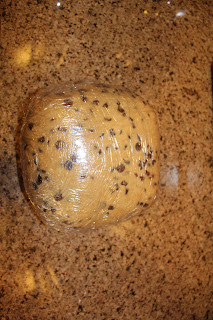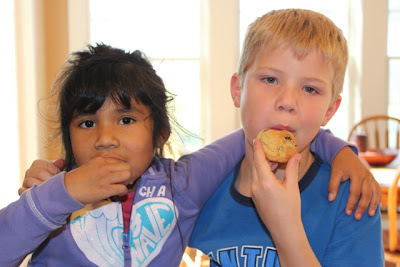My sister and her husband Chris are adopting a niece for me. It's the second time my sister has taken one for the team and brought me home a niece from another country.
My sister is great like that.
Our niece Zahria was adopted from Kazakhstan, and her new little sister is coming to our family by way of Columbia, South America. We're calling her our little Columbian Bean until she's in the country and everything is all legal and stuff. Dang that Hague Convention, anyway.
Before Zahria came home I made her a small quilt, which has been well-loved in the past five years. Lil' Bean needs a quilt of her own, so Z helped her mom pick out some material and they sent it my way. Zahria chose the cupcakes, which is the sweetest but also proved to be the most maddening to work with. More on that later. In any case, I decided on a simple square pattern and kind of made things up as I went along. In case you have a sweet little one headed to your family and you feel like putting your love into fabric-form, some rudimentary instructions follow.
My sister sent 9" by 44" of the cupcake fabric and 18" by 44" of the dot, blue owl and yellow fabrics. She also sent a length of bright pink which I used for the border and backing. I forgot to measure that for you before I used it--sorry. Go with two yards. All of the fabrics were flannel, though that cupcake was a different type than the others, almost like a pajama-knit-flannel. Try to get the same type/thickness of each of the fabrics, and avoid stretchy fabric like the plague. You will thank me for taking that advice. More on that later.
Because of the amount of fabric I had, I needed to cut my squares into 4.5 by 4.5 inch pieces. It would be easier for you to just go with 5 by 5, but you roll with whatever works for you.
If you don't own a rotary cutter, a cutting mat and a plastic ruler-thingy, I would strongly recommend buying them before taking on any quilting project. You can buy them at Amazon.com here, or in any fabric store. Walmart even carries them.
When cutting fabric, it is simplest to first cut strips that are 4.5" wide, and then cut each strip into 4.5" pieces. You can find directions all over the internet for how to cut strips, including videos. You might start with this one.
You should end up with stacks of squares. Feel free to iron them at this step, but I didn't.
Now comes the step that took me forever. Not really, but I spent a lot of time on it. Arrange the squares however you would like. For Zahria's quilt, which was primarily chenille, I randomly placed squares. I know random sounds like it would take the least amount of time, but it didn't because I didn't want two of the same type of squares touching. The randomness took a lot of planning. But I'm bad at random, so maybe that was just me. I ended up with this design for Lil' Bean's quilt, which was 9 squares by 11 squares, for a total of 99 squares. (Those are my mad math skills coming through there). You could certainly go larger; there were quite a few unused squares from this project. Since this quilt is for snuggling in the car, in the rocking chair, and on aunties' laps, I wanted a smaller size.
There is an efficiency to quilting squares, and if you follow the logic it will save you a ton of time and frustration. Do this. Flip the second column of squares onto the first column of squares. Then starting at the bottom, stack each set so the top squares are on the top of your pile.
When you sew the right edge together, begin sewing the top two squares but then DON'T stop the sewing machine or cut the thread. Pretend you are in an assembly line in a sweatshop somewhere, and sew the second set of quilt squares with just a small space of thread between them without stopping the machine. A huge time saver.
See what I mean? You'll end up with a connected group of squares.
Snip them apart and stack them, keeping the bottom set on the bottom and working your way up to the top. That order is important. If you forget it, your pattern is going to be way off and you'll end up with a random quilt, even if you hadn't planned on one!
Go back to the quilt squares arranged on your floor. Starting at the bottom again, stack the next column of squares.
Arrange them at your machine so the sewn pairs are next to the squares from the next column. Again, notice that the top squares are on top.
Open up the sewn pair and lay the solo square on top of the right side, "good" (printed) sides touching, lining up the edges.
Now sew that third column of squares onto the second column squares. Again, do not stop your machine between squares. Repeat those steps, sewing all of the columns of squares to make your rows.
When all of the rows have been sewn, you will need to iron the seams. This is really super important because this little trick is going to help your squares "lock" so the edges are perfect. Or it will if you do not have cupcake fabric. The cupcake fabric STRETCHED insanely when I ironed the seams. That meant all of my squares were 4.5 x 4.5 except those cupcakes, which became like 6 x 4.5 and caused havoc through the remainder of my project.
Iron row 1 with all of the seams going to the left (raw edges pointing left) as shown above. Then iron all of row 2 seams going to the right (raw edges pointing right). Row 3 will go left, row 4 will go right, and repeat through row 11. Row 11 will be ironed to the left because it is an odd-numbered row. Holy math skills, Robin.
You're ready to sew row 1 to row 2. Put the good sides together, and pin at each intersection of squares. Notice how the edges "lock" because one seam goes one way and the other seam goes the other way? That's what you want. And this is what you don't want:
If your fabric has stretched in the ironing, your corners are not going to meet. That is maddening. You'll then be forced to attempt to stretch fabric and fudge tiny little gathers to try to get the edges to meet. Your squares won't form perfect corners and the quilt will be a dead loss. Or you'll just have to live with some imperfect corners. Apparently the Amish (or some such group) say no quilt is perfect because only God is perfect, so if that helps you feel ok with it, then go with that. I do.
When all of your rows are sewn together, iron the seams between rows in the same direction.
Tada! You have the quilt top primarily done. Now to sewn a border onto it. I cut 3 inch by 44 inch strips of the same fabric I used as backing for the quilt. As a general rule, do some measuring before you cut. This worked for me because none of the sides of my quilt were longer than 44". If you used more than 99 squares, yours might be.
Pin a strip of border to the left and right sides of your quilt.
Be certain to pin at each of the seams, ensuring the seams are sewn down in the direction they were ironed.
After you sew each strip of border, lay the quilt flat on your ironing surface, then push the border up and iron it flat.
The left and right sides of the border should be sewn on first, then the top and bottom.
You could stop and bind the quilt at this stage and call it good. I had to put a little something extra onto Lil' Bean's quilt because I couldn't let well-enough alone.
I sewed pom pom trim onto the edge of the border. There was just a small amount of edging on the pom pom trim, so this step was a little tricky. You can't see it from the pictures, but the edging of the pom pom trim is actually on the RIGHT side. That was intentional, because when you sew the backing on you will flip the quilt inside out and the pom poms will be sandwiched between the top and back of the quilt, obviously poking out. It's hard to explain. Just trust me. If you are going to sew pom pom trim, sew the edge of the trim so the pom poms are facing into the middle of the quilt and the edge of the trim is facing the outside edges.
After the pom pom trim was sewn around the edge, I assembled all three layers of the quilt to combine them. Spread the top of the quilt on a hard surface so the good side is up. Then lay the backing of the quilt so the good side is down. (Notice the good sides will be touching). Then lay your batting on the top. It's much easier to sew if you use a smooth batting like this one. Pin everything securely in place. Trim so the edges are even and you can see all three layers. Then sew around the outside edge. You hope to catch the edge of the pom pom trim in that, too, if you can--but it's almost impossible to see it when you're sewing.
DON'T SEW IT ENTIRELY SHUT or your quilt will be inside out. Leave a small space (above), maybe 8 inches, unsewn. Then flip the quilt inside out, so it actually ends up right side out. Know what I mean? Your batting should now be on the inside of the quilt, and the top and back are good sides out. You will need to hand-stitch the 8 inches remaining closed.
You could call it good at this point, but it's not a bad idea to do some type of quilting to secure the batting inside the quilt so it doesn't shift after washings and repeated love. I chose to hand-stitch around the border.
I also cut off pom poms from the left over trim, used pink embroidery floss and secured a pom pom to the center of each of the cupcake squares.
And then I called it good enough.
Now comes the hardest part. Waiting the excruciatingly long wait for the paperwork to be accepted that will allow our sweet Lil' Bean to come home. I can hardly wait to snuggle her, with or without a quilt!
















































